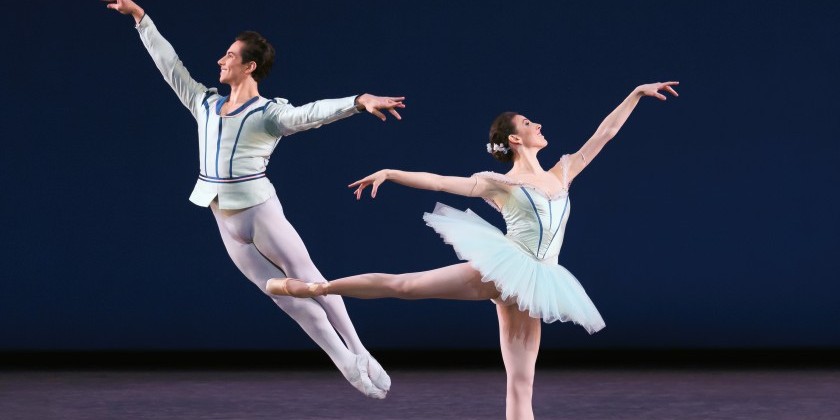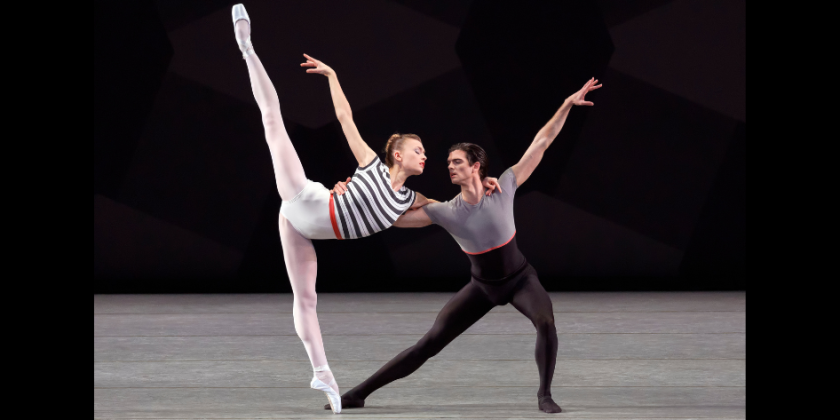IMPRESSIONS: New York City Ballet’s 2019 Spring Season — Week 5 and 6

Lincoln Center, NYC
May 23, 7:30PM (Conductor: Clotilde Otranto)
May 28, 7:30PM (Conductor: Daniel Capps)
Daniel Ulbricht grabs the right side of his head fetching the piece of broken gold crown that dangles from his wig. He holds on to the chunk, like a well-deserved trophy, through the end of his solo, finally discarding it as he exits the stage.
These moments of onstage alertness make live performance thrilling.

As “Oberon,” Ulbricht’s superb instinct guides him through all kinds of intended trouble. The hilariously convoluted mix-ups in Shakespeare’s A Midsummer Night’s Dream never fail to entertain. And funnily Ulbricht with half a crown looks better than he did with the original headpiece. As light as that crown may be, it weighs him down, but the half of it looks elegant. Ulbricht brings the bearing of a danseur noble to the role and I want to congratulate him on this choice. (I advocate that the head gear mishap happened fortuitously so the costume design could be reconsidered.)
Taylor Stanley flexes his muscles and vamps his way through the role of “Puck.” His energy delights the audience, his beauty enchants me. Sara Mearns (for the injured Maria Kowrowski) plays an active and somewhat demonstrative “Titania.” Mearns is such an accomplished dancer that my criticism should be taken with a grain of salt, yet I wonder if the magic of the role could be magnified by her doing less. After all, “Titania” is the receiver of the spell —and its resulting flirtation with the ass “Bottom”— not its originator. Preston Chamblee, as the hungry, long-eared animal, gets every laugh.

The crisscrossed lovers “Helena,” “Hermia,” “Lysander,” and “Demetrius” receive engaging portrayals by Brittany Pollack, Ashley Laracey, Aarón Sanz, and Peter Walker. Megan LeCrone as “Hippolyta" is surefooted and fierce. It’s an altogether lively and lovely first act.
The second act features a pas deux that as “divertissement” has nothing to do with the story. It serves up a vision of perfection. I reckon that Balanchine meant to capture the divine in an earthly pairing. After all the stress that Shakespeare put us through just before, here is a reminder that everything is beautiful at the ballet.
How I wish that Megan Fairchild and Tyler Angle would find a common breath to crown their impressive individual achievements. Unfortunately their joint effort falls flat. There is no fault, yet there is no discovery.

Under the baton of Daniel Capps for the New York City Ballet Orchestra and Kent Tritle, music director of Musica Sacra, Mendelssohn’s score was a treat for the ears. The children who appeared in this production (rehearsed by Dena Abergel and Arch Higgins) deserve a special applause. At the end of the season it is a gift to see young dancers take the stage with enthusiasm, exactitude, and joy. It gives me hope for many seasons to come.
Looking at the season’s programming, I wonder why the warhorse Stars and Stripes appeared on the same evening as the evergreen Dances at a Gathering. But even flawed programming could not conceal the fact that there is great young talent in the company’s ranks.

The women have the harder task to distinguish themselves because of the uniformity of hairstyle, look, and the fact that many Balanchinian corps arrangements do not focus on individuality. A crop of proficient young men is led by Roman Mejia whose spitfire talent comprises impeccable technique, phenomenal ballon, and personality to match. His appearance in Dances… will be forever memorable. Other standouts include Daniel Applebaum (promoted to the rank of soloist during the season), a muse to choreographer Justin Peck, but equally effective in other repertoire, and Harrison Ball, who manages to handle and match Ashley Bouder’s “Liberty Bell” as her “El Capitan.”
The most revelatory debut in a role turned out to be Joseph Gordon’s performance in Theme and Variations, as part of Tschaikovsky Suite No.3. Gordon’s wild heart completes the arc of an evening which features the implausible pairing of Brahms-Schoenberg Quartet and the Tschaikovsky Suite.
In the last section of this dance, a celebration of classicism, Gordon brings sensual untamed romance to the perfection of the imperialist order. While he fits in and excels technically, his focus makes us long for a world beyond the confines of court. The quality of appearing “untamed” is too often associated with young horses, but I wonder if this was the very trait that propelled Nureyev to superstardom.

The new artistic directorial team inherits a company full of talent. And the future looks brighter now that abuse allegations have been investigated and dealt with. Programming will be key going forward.
The backbone of New York City Ballet is not only the vast repertoire by Balanchine and Jerome Robbins, but also the production of new work. I hope enough time will be set aside for fresh creations by resident choreographer, Justin Peck, and others. Not every choreographer works at the speed of Balanchine (or Martins). Most great dances require time. The ballet world would be far less interesting without the masterworks of Antony Tudor and Robbins, both notorious ponderers. New York City Ballet has the artistic resources (and hopefully the financial ones) to make relevant work for the present and the future.













